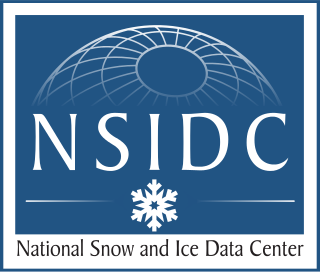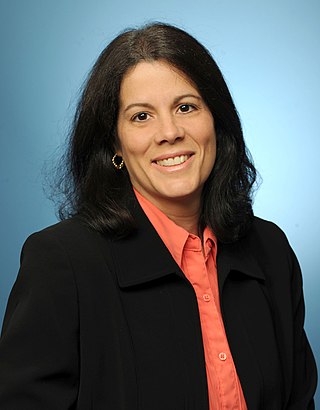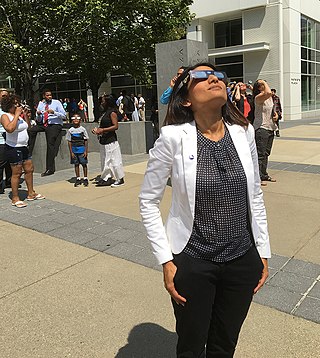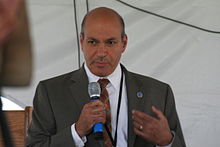
The Goddard Space Flight Center (GSFC) is a major NASA space research laboratory located approximately 6.5 miles (10.5 km) northeast of Washington, D.C. in Greenbelt, Maryland, United States. Established on May 1, 1959 as NASA's first space flight center, GSFC employs about 10,000 civil servants and contractors. Named for American rocket propulsion pioneer Robert H. Goddard, it is one of ten major NASA field centers. GSFC is partially within the former Goddard census-designated place; it has a Greenbelt mailing address.

Lawrence James DeLucas is an American biochemist who flew aboard NASA Space Shuttle mission STS-50 as a Payload Specialist. He was born on July 11, 1950, in Syracuse, New York, and is currently married with three children. His recreational interests include basketball, scuba diving, bowling, model airplanes, astronomy and reading.

The National Snow and Ice Data Center (NSIDC) is a United States information and referral center in support of polar and cryospheric research. NSIDC archives and distributes digital and analog snow and ice data and also maintains information about snow cover, avalanches, glaciers, ice sheets, freshwater ice, sea ice, ground ice, permafrost, atmospheric ice, paleoglaciology, and ice cores.

The Goddard Institute for Space Studies (GISS) is a laboratory in the Earth Sciences Division of NASA's Goddard Space Flight Center affiliated with the Columbia University Earth Institute. The institute is located at Columbia University in New York City. It was named after Robert H. Goddard, American engineer, professor, physicist and inventor who is credited with creating and building the world's first liquid-fueled rocket.

The Cooperative Institute for Research in Environmental Sciences (CIRES) is a research institute that is sponsored jointly by the National Oceanic and Atmospheric Administration (NOAA) Office of Oceanic and Atmospheric Research (OAR) and the University of Colorado Boulder (CU). CIRES scientists study the Earth system, including the atmosphere, hydrosphere, cryosphere, biosphere, and geosphere, and communicate these findings to decision makers, the scientific community, and the public.
The Earth Institute is a research institute at Columbia University created in 1995 for addressing complex issues facing the planet and its inhabitants, with a focus on sustainable development. With an interdisciplinary approach, this includes research in climate change, geology, global health, economics, management, agriculture, ecosystems, urbanization, energy, hazards, and water. The Earth Institute's activities are guided by the idea that science and technological tools that already exist could be applied to greatly improve conditions for the world's poor, while preserving the natural systems that support life on Earth.

Chief Scientist is the most senior science position at the National Aeronautics and Space Administration (NASA). The chief scientist serves as the principal advisor to the NASA Administrator in science issues and as interface to the national and international science community, ensuring that NASA research programs are scientifically and technologically well founded and are appropriate for their intended applications.

Amri Hernández-Pellerano is a Puerto Rican electronics engineer and scientist who designs, builds and tests the electronics that will regulate the solar array power in order to charge the spacecraft battery and distribute power to the different loads or users inside various spacecraft at NASA's Goddard Space Flight Center. She designed the power systems electronics for the Wilkinson Microwave Anisotropy Probe (WMAP) mission. WMAP is a NASA Explorer mission spacecraft which measures the temperature of the cosmic background radiation over the full sky with unprecedented accuracy.

Inez Fung is a professor of atmospheric science at the University of California, Berkeley, jointly appointed in the department of earth and planetary science and the department of environmental science, policy and management. She is also the co-director of the Berkeley Institute of the Environment.

Goddard Space Flight Center is NASA's first, and oldest, space center. It is named after Robert H. Goddard, the father of modern rocketry. Throughout its history, the center has managed, developed, and operated many notable missions, including the Cosmic Background Explorer, the Hubble Space Telescope, the Tracking and Data Relay Satellite System (TDRSS), the Lunar Reconnaissance Orbiter, and the Solar Dynamics Observatory.
W. Timothy Liu is an American meteorologists and atmospheric scientist. He became a Fellow of the American Meteorological Society in the year 2000, a Fellow of American Association for the Advancement of Science in 2007, and most recently an American Geophysical Union Fellow (2011). By the end of 2008 he had published 145 refereed journal articles or reviewed book chapters, and has authored over 260 publications in total.

William J. (Bill) Borucki is a space scientist who worked at the NASA Ames Research Center. Upon joining NASA in 1962, Borucki joined the group conducting research on the heat shield for Apollo program spacecraft. He later turned his attention to the optical efficiency of lightning strikes in the atmospheres of planets, investigating the propensity that these lightning strikes could create molecules that would later become the precursors for life. Subsequently, Borucki's attention turned to extrasolar planets and their detection, particularly through the transit method. In light of this work, Borucki was named the principal investigator for NASA's Kepler mission, launched on March 7, 2009 and dedicated to a transit-based search for habitable planets. In 2013, Borucki was awarded the United States National Academy of Sciences's Henry Draper Medal for his work with Kepler. In 2015 he received the Shaw Prize in Astronomy.
George H. Ludwig was the former chief research scientist for the National Aeronautics and Space Administration's satellite systems and director of operations for the National Oceanic and Atmospheric Administration. He played a key role in adapting solid-state scientific research instruments for America's first satellites: Explorer I, II, and III. He wrote a book, and provided audio/oral history with the Transistor Museum.
James Vladimir Taranik was an American scientist and educator who worked in the area of earth-observation satellite remote sensing. He was Chief of NASA's Non-Renewable Resources Branch and Program Scientist of the Space Shuttle's first scientific flights with cargo that included experiments related to geology, atmospheric chemistry, meteorology, marine biology, and plant physiology in the earth and life sciences. He also held various positions in the Nevada System of Higher Education, including the Desert Research Institute and the Mackay School of Earth Sciences and Engineering.

Dr. Mamta Patel Nagaraja is an American engineer and scientist, and currently the Associate Chief Scientist for Exploration and Applied Research. In this role, she advises NASA's chief scientist on missions where humans perform science in spaceflight. She has degrees in aerospace engineering, mechanical engineering, and biomedical engineering. Her dissertation research was in molecular biology where she studied genetic changes in bone cells exposed to simulated microgravity. She previously received two interviews to become a NASA astronaut, served on the NASA Administrator's team, led a science communications portfolio, and served on a White House Council.

Claire Lucille Parkinson is an American Earth scientist and climatologist at NASA's Goddard Space Flight Center.
Bronwen Konecky is a paleoclimatologist and climatologist whose particular area of focus lies in the past and present effect of climate change in the tropics. She is an assistant professor in the Department of Earth and Planetary Sciences at Washington University in St. Louis.
Gretchen Keppel-Aleks is an American scientist and assistant professor at the University of Michigan in the College of Engineering's department of Climate and Space Sciences and Engineering. She primarily focuses on Earth's climate and the effects of greenhouse gasses on Earth's atmosphere. Keppel-Aleks has been named a Kavli Fellow by the U.S. National Academy of Sciences.
Sinéad Louise Farrell is a British-American space scientist who is Professor of Geographic Sciences at the University of Maryland, College Park. Her research considers remote sensing and climate monitoring. She was science lead for the ICESat-2 Mission, which used laser altimetry to make height maps of Earth.











